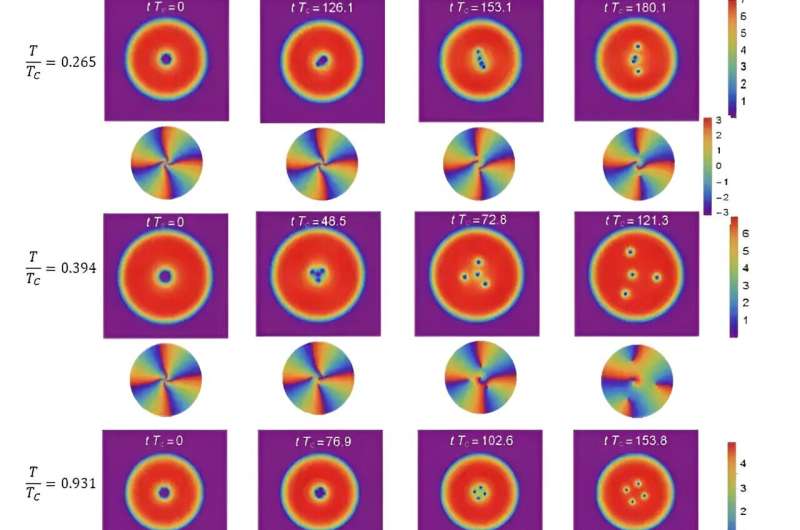This article has been reviewed according to Science X's editorial process and policies. Editors have highlighted the following attributes while ensuring the content's credibility:
fact-checked
peer-reviewed publication
trusted source
proofread
Study finds quantum state of a rotating superfluid can discharge in three ways

According to a recent study from the University of Helsinki, published in the journal Physical Review Letters, a vortex of a superfluid that has been quantized four times has three ways of dividing, depending on the temperature.
The fluid transforms into a superfluid near the absolute zero point of temperature (approximately -273°C). Internal resisting forces, such as friction, disappear. At this point, the behavior of the fluid can no longer be described using classical mechanics; instead, quantum physics must be applied.
When a superfluid is spun, the resulting rotation should never slow down because superfluids have no viscosity or friction. This has been experimented with at the atomic level using helium at very slow rotation, and it was observed that the superfluid, however, eventually halted.
The reason is that the vorticity of a superfluid becomes quantized: overall twirling breaks down into small vortices—the angular momentum is both quantized and persistent and therefore does not disappear.
Rotation is restricted
A regular vortex—such as water draining from a sink—can spin on its axis at any speed, whereas the angular momentum of a quantized vortex is always proportional to an integer. This integer is called the winding number. The winding numbers of individual and quadruply quantized vortices are one and four, respectively.
A quadruply quantized vortex easily splits into four singly quantized vortices because a quadruply quantized vortex is more unstable due to the system's energy significantly decreasing after the splitting. Lower energy means a more stable system.
Doctoral researcher Xin Li from the University of Helsinki investigated the splitting processes of quadruply quantized vortices in his recent work. What happens when an unstable, quadruply quantized vortex is allowed to exist at three different temperatures, all still very close to absolute zero?
Three temperatures, three ways of splitting
In the study, it was observed that quadruply quantized vortices have three ways of splitting, leading to three different patterns. Although these patterns had been theoretically identified in previous studies, the results demonstrated for the first time that temperature leads to different splitting processes.
The splitting was modeled by applying a relatively new theory to the phenomenon, known as the gauge/gravity duality or holography. This duality allows for a systematic examination of the temperature's impact in a way that bears close resemblance to a realistic situation.
The study indicates that two observed patterns exist in the low-temperature range, while a third pattern may emerge if the temperature is further increased. Experimentally, two of these splitting patterns have been observed so far, and the researchers suggest that at a higher temperature, a new pattern could become visible.
More information: Shanquan Lan et al, Heating Up Quadruply Quantized Vortices: Splitting Patterns and Dynamical Transitions, Physical Review Letters (2023). DOI: 10.1103/PhysRevLett.131.221602. On arXiv: DOI: 10.48550/arxiv.2311.01316
Journal information: Physical Review Letters , arXiv
Provided by University of Helsinki




















